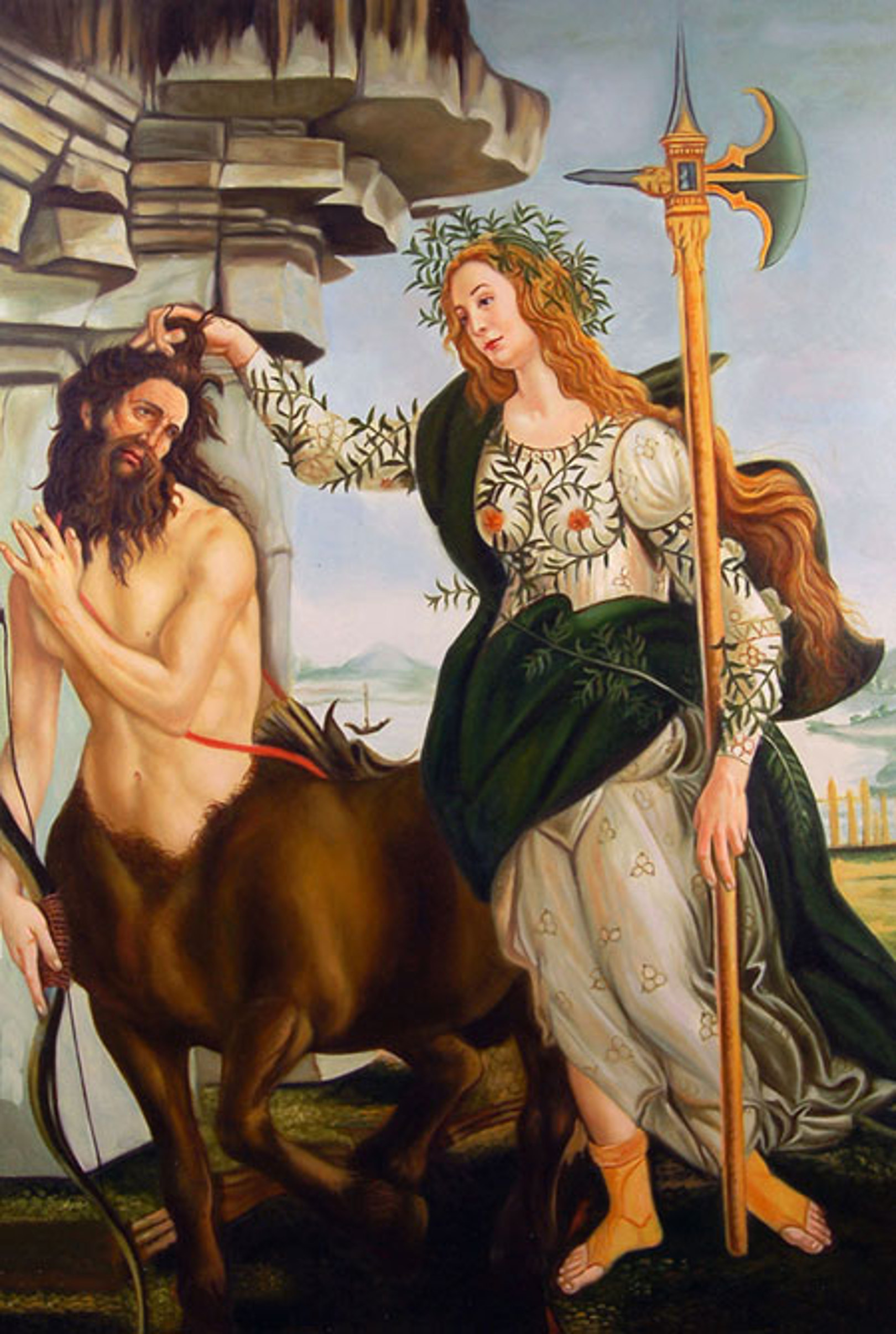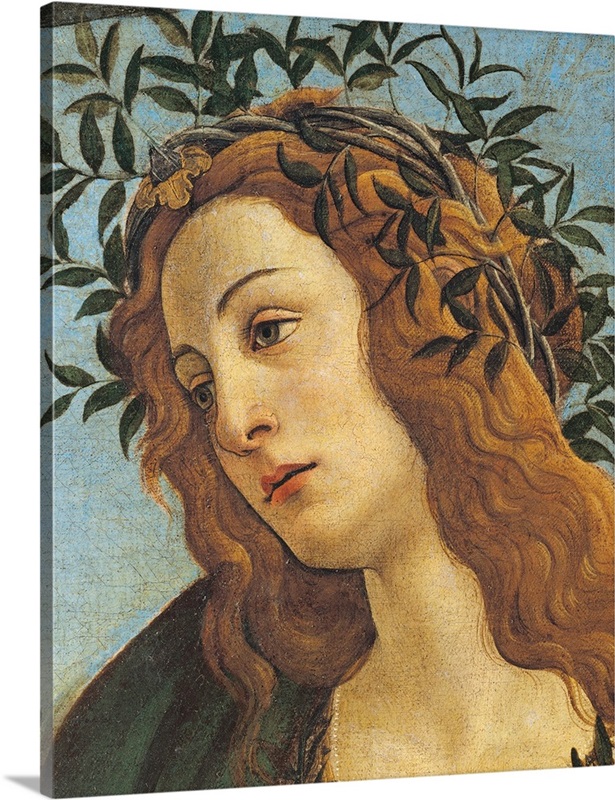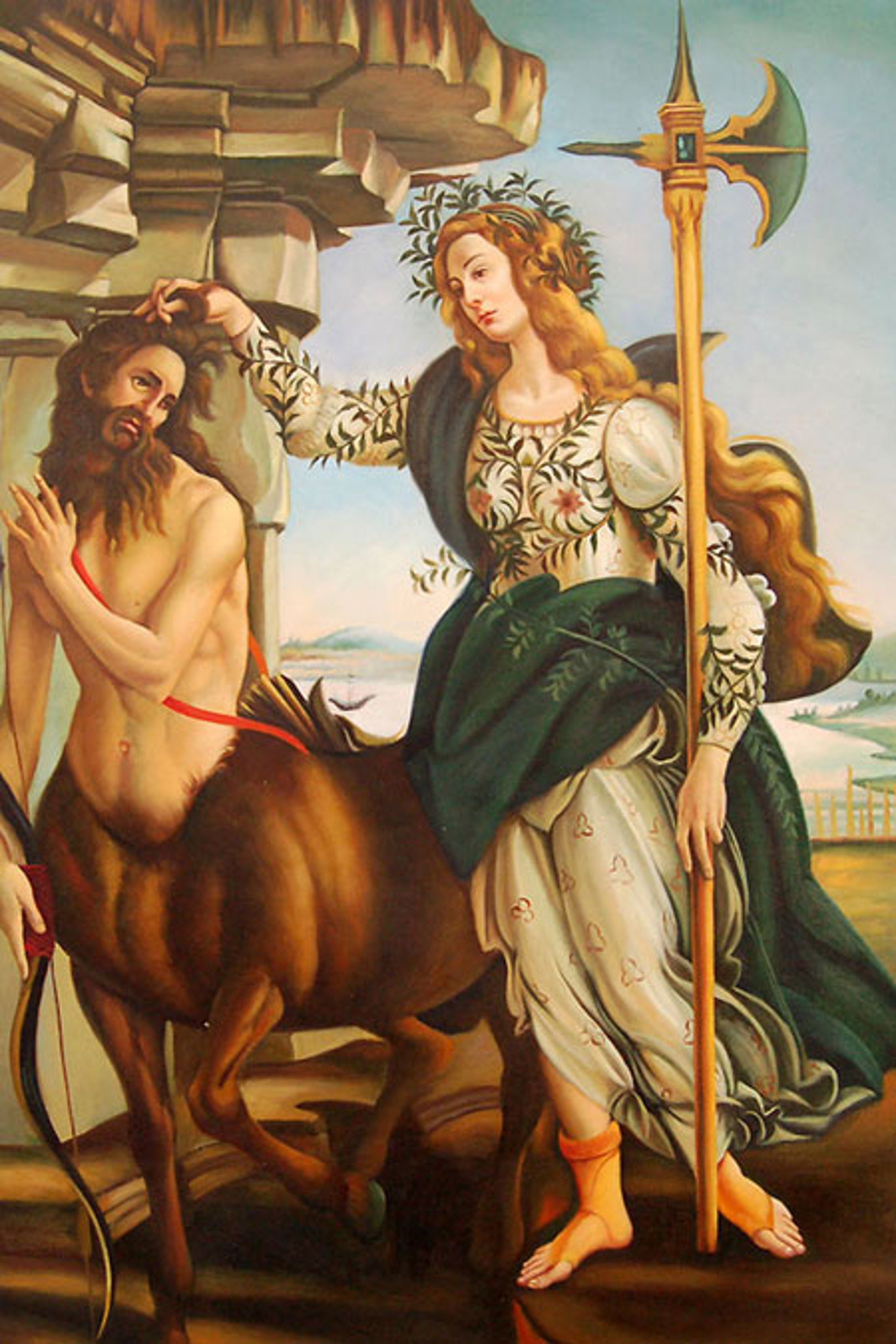
1482 Sandro Botticelli Pallas et le Centaure, Détail...I love Boticelli Sandro botticelli
Pallas and the Centaur is a painting by the Italian Renaissance painter Sandro Botticelli, c. 1482. It is now in the Uffizi Gallery in Florence. It has been proposed as a companion piece to his Primavera, though it is a different shape. The medium used is tempera paints on canvas and its size is 207 x 148 cm.

Pallas and the Centaur Painting in the Uffizi Gallery in Florence on October 19, 2019 Editorial
The centaur, a mythical creature, combining man and beast, symbolises the feral instincts of humanity and therefore, the work is to be understood as an allegory to virtues that act as a brake on a bad-tempered, passionate temperament. A young woman wears a dress with repeat decoration of the three-ring insignia of the Medici family.

Афина и Кентавр. 1482 год, Галерея Уффици, Флоренция. Сандро Боттичелли Botticelli paintings
Pallas and the Centaur is the title of a painting created by Italian artist Sandro Botticelli. Botticelli, who lived from 1445 to 1510, was an important artist in the Italian Renaissance, a.
/https:%2F%2Fblogs-images.forbes.com%2Fceciliarodriguez%2Ffiles%2F2015%2F09%2F8.-Pallas-and-the-Centaur-c.1482-by-Sandro-Botticelli-c-Galleria-degli-Uffizi-Florence-2015.-Photo-Scala-Florence-e1441300906621-1152x645.jpg)
Botticelli's Beauties to Be Showcased at London's V&A Museum
Pallas et le Centaure Pallas et le Centaure modifier - modifier le code - modifier Wikidata Pallas et le Centaure fait partie des œuvres profanes de Sandro Botticelli peinte autour de 1482. C'est une scène mythologique qui marque un tournant dans la carrière de l'artiste.

Quadro Pallas e Centauro di Classici, falso d'autore 90x60cm Classici
Pallas et le Centaure fait partie des œuvres profanes de Sandro Botticelli peinte autour de 1482. C'est une scène mythologique qui marque un tournant dans la carrière de l'artiste.

Pallas and the Centaur by Botticelli Artworks Uffizi Galleries
Pallas Athena. Athena was an ancient Greek goddess who was often given the epithet and described as Pallas. She is associated with wisdom and warfare and was later syncretized with the Roman goddess Minerva. Athena's epithet Pallas is derived either from the Greek word meaning "to brandish as a weapon," or from Greek words, meaning.

"Pallas and the Centaur Sandro Botticelli" Scarf for Sale by LexBauer Redbubble
Help Category:Pallas and Centaur (Botticelli) From Wikimedia Commons, the free media repository Pallas and Centaur (Botticelli) Media in category "Pallas and Centaur (Botticelli)" The following 19 files are in this category, out of 19 total. Botticelli, pallade e il centauro 00.jpg 850 × 1,204; 150 KB Palas y el Centauro.jpg 781 × 1,117; 323 KB

Sandro Botticelli Pallas and the Centaur 14821483 Tempera on canvas 207 x 148 cm Uffizi
Pallaset le centaure Sandro Botticelli,1480-85 Tempera sur toile, 207 x 148 cm Florence, Galerie des Offices Pour ce tableau aussi de nombreuses interprétations ont été avancées. Celle qui semble la plus plausible en regard de la symbolique humaniste fait de la sagesse (Pallas) celle qui domine l'instinct (Le Centaure),

Botticelli Pallas La Calomnie saint Augustin Judith Uffizi
Uffizi artwork ID pallas-and-the-centaur. Florentine musea catalogue ID. part of the series: Q117361736. Greek mythology. Pallas and the Centaur (1482), by Sandro Botticelli. Tempera on canvas, 204 × 147.5 cm (80 × 58.1 in).

Pallas et le Centaure — Wikipédia Centaure, Peinture renaissance, Peintre
La peinture représente la déesse Pallas, cette Minerve, armée d'une lourde hallebarde et vêtue de tissus transparents brodés. Avec la main droite tient par les cheveux un centaure. Selon une lecture philosophique, la scène est censée représenter le contraste entre la raison et l'instinct, ou entre l'humilité et l'orgueil ou entre la.

Pallas And The Centaur (Minerva And The Centaur), By Botticelli, 14821483. Wall Art, Canvas
The centaur - a creature combining man and beast - symbolises the feral instincts of humanity - uncontrolled passion, lust and sensuality. So, noting this centaur's submissive position, this painting represents submission of passion to chastity and reason. 'Pallas and the Centaur' by Sandro Botticelli

Pallas et le Centaure Sandro Botticelli (1482) Botticelli, Portrait, Painting
Pallas et le centaure - Sandro Botticelli. Artiste : Botticelli, Sandro (1444 ou 1445-1510) Date : 1482. Pallas, symbole de la raison et de la tempérance, apprivoise le Centaure, Pierfrancesco, qui était débauché et cruel. Sur sa robe, on distingue les trois anneaux symboles des Médicis.
.jpg)
Pallas y el Centauro, c14801485, 1937.
Pallas et le Centaure fait partie des œuvres profanes de Sandro Botticelli peinte autour de 1482. C'est une scène mythologique qui marque un tournant dans la carrière de l'artiste.

FileP1040669 Sandro Botticelli Pallas et le centaure.jpg
Pallas and the Centaur is a painting by the Italian Renaissance painter Sandro Botticelli, c. 1482. It is now in the Uffizi Gallery in Florence. It has been proposed as a companion piece to his Primavera, though it is a different shape. [1] The medium used is tempera paints on canvas and its size is 207 x 148 cm.

SANDRO BOTTICELLI ( 1445 1510) Pallas et le Centaure (detail).
L'oeuvre "Pallas et le Centaure", peinte en 1482 par l'artiste peintre et Grand Maître Sandro Botticelli, exposée au musée Galleria degli Uffizi à Florence, appartient au mouvement Renaissance. Titre du tableau : Pallas et le Centaure Peintre : Sandro Botticelli Type de peinture : Détrempe sur toile Année : 1482 Mouvement : Renaissance Exposition :

Quadro Pallas e Centauro di Classici, falso d'autore 90x60cm Classici
Alessandro di Mariano di Vanni Filipepi, dit Sandro Botticelli, est un peintre italien, né à Florence le 1 er mars 1445 1, 2 et mort le 17 mai 1510 dans la même ville. Botticelli est l'un des peintres les plus importants de la Renaissance italienne et de l' histoire de l'art . Biographie Origines et famille